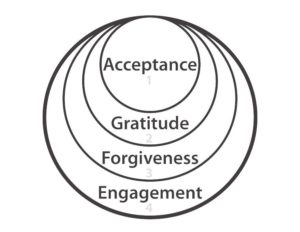Using our healing model to address a problem or issue
With these 10 steps in mind, a real-life situation might play out this way. After a painful night, buffeted by grief, sad memories, regret, and sobbing, feeling spent and directionless, we can connect with our loved one.

Using the methods described in Part 2 of this Chapter, we may take some or all of the steps that open us up to authentic communication with them.
We breathe in the love of our departed one.
As a problem or issue will be in our mind and heart, questions may form in our mind that we can direct toward our loved one: questions like those in the Reflective Pauses that follow Chapters 7 through 10. Then, we might consider how we could contemplate the four Gateways, one after another, beginning with Acceptance.
Looking again at our healing model…

… we may imagine approaching and passing through each Gateway, asking our questions and holding our issues and concerns in our hearts.
We may stay open to two other questions, “Where might these Gateways lead?” and “Where else might these Gateways lead?” And we may listen to what comes back from our inner wisdom and from our loved one.
Approaching the ACCEPTANCE GATEWAY
Our loved one’s guidance and our intuition will draw us to the first Gateway of Wisdom: Acceptance. In our imagination, as we approach it, we may spell out our question or explain inquiry. We may need reminders of our new harsh reality and the need to receive help from family, friends, and professionals. We may hear our loved one offer specific guidance about Acceptance — if that is what needs healing attention at this time. If we listen deeply, we will receive clear and specific guidance related to the subject of our inquiry.

Approaching the GRATITUDE GATEWAY
As we approach the second Gateway, we may again read messages and voice our questions as we share any confusion or bewilderment.
Gratitude is highly challenging work for a bereaved person. It’s deep soul work and lays the foundation for experiencing the next two realms. What if we find nothing in our circumstances to appreciate?
“What next?” we may hear our departed one call out to us. One question that could arise is, “How can we more fully embrace and transform ingratitude — ours — and others’?”
Sometimes, these conversations and questions (What next? What does this mean?) may lead our loved one to confront us directly, guiding us toward the third Gateway: Forgiveness. There they may ask us to sense the power of Forgiveness that we have already experienced — to taste and remember its flavor as we face new forgiveness challenges. As we frame our inquiry at this Gateway, we may sense an underlying question or gentle prodding: “Have I truly forgiven myself?”
We may focus on forgiving the one who has died. That’s appropriate, of course.
And we may hear:
But what about me? Why did he have to leave? Would he have chosen to live longer if he’d had perfect confidence that I’d take care of him? Where and how did I miss that critical message that may have caused me to lose him? I feel so guilty about that.
How we can we tenderly love — and forgive — our wounded, bereft, and aching self?
At the Forgiveness Gateway, we may be asking ourselves how we can we tenderly love — and forgive — our wounded, bereft, and aching self?
I struggled mightily with Forgiveness. Back and forth across the threshold, cursing its challenges, I screeched at the barking hound of my self-recrimination. I have lurked around that formidable Gateway for days, weeks, even. Abiding in denial, I edged away from it.
Then I would hear my sweet Beloved’s gentle plea:
Come on, Wadie. You know what I am saying is the truth. We need to face this if we are going to move on. We must forgive ourselves.
In such circumstances, we may fail to frame intelligent questions for the departed one. “Please help me” or “What else is there to forgive?” may be the best we can muster at this Gateway. And then we might pray for guidance and a release from our suffering.
For some of us, the reward for this painful to-and-fro of fear, denial, and procrastination may arise as we approach the Gateway of Engagement. As we framed our painful questions and discussed our perplexing issues, we may have heard our loved one’s voice, remembering their values and their preferences. We may recall their unique style, their Giveaway: what they supported in their human life. The impulse to take our grief “out and about” into our wider community might not need as much of our direction as we might imagine.
LIFE IS A powerful magnet
Life itself — our wider community — is a powerful magnet, a compass that can draw a grieving person back into life, into service with a mission that celebrates the life of our loved one.
At this Gateway and in its terrain, our departed one, responding to our desperate “What now for me?” questions, may set a tone for our survivor mission by reminding us of who they were — and still are.

A LONGING voice…
By this time, deep inside our brokenness, we may hear a voice — our voice — longing to speak out in public, rather than to suffer in private. Entering the realm of Engagement — the sacred work of sorrow — in no way restricts us from re-entering the three realms that we have already traversed. There will always be times when a re-entry — a revisiting and refreshing — will be necessary — and welcome.
As our healing deepens, we may find we have less need to dwell in the realm of Acceptance. However, the Gateways of Gratitude and Forgiveness may continue to beckon and challenge us. And then one day, when we least expect it, a sense of reconciliation may arise, so sweetly and gently, that we might almost miss it.
Except for the grace that accompanies it.
